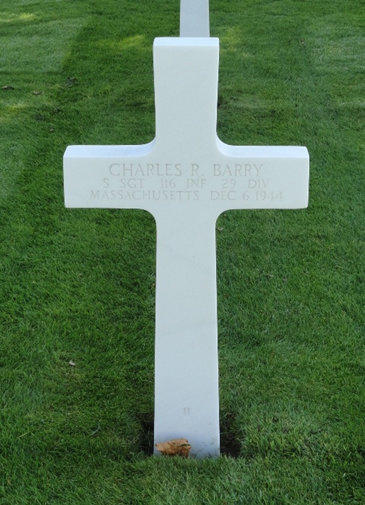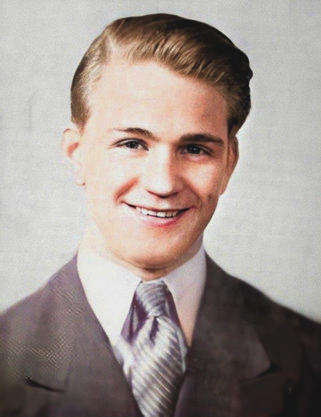
copyright © Wartime Heritage Association
Website hosting courtesy of Register.com - a web.com company
Wartime Heritage
ASSOCIATION
Remembering World War II
Charles Ross Barry


Source:
American Battle Monuments Commission – Charles Ross Barry
American Battle Monuments Commission - Netherlands American Cemetery and Memorial
Fields of Honor
Find a Grave
Name:
Charles Ross Barry
Rank:
Staff Sergeant
Service Number:
31307245
Service:
E Company, 116th Infantry Regiment
29th Infantry Division, US Army
Awards:
Purple Heart with Oak Leaf Cluster
Date of Birth:
August 27, 1924
Place of Birth:
Halifax, NS
Date of Enlistment:
March 30, 1943
Place of Enlistment:
Boston, Massachusetts
Address at Enlistment: Roxbury, Suffolk Co., Massachusetts
Age at Enlistment:
18
Height:
5 feet, 10½ inches
Complexion:
Fair / Light
Hair Color:
Brown
Eye Color:
Hazel
Marital Status:
Single
Occupation:
Checker
Next of Kin:
Daniel Barry (Father)
Date of Death:
December 6, 1944
Age:
20
Cemetery:
Netherlands American Cemetery and Memorial
Grave:
Section K, Plot 20, Grave 11
Charles Ross Barry was the son of Daniel Allen Barry (1896-1951) and Ann (MacIntyre) Barry (1900-1960).
His father was born in Halifax, NS; his mother was born in Port Hawkesbury, in Cape Breton. Charles had a
sister Dolores (born in 1929).
Charles and his family moved to the US in
February 1925, travelling by train via New
Brunswick to Maine. They lived at 480 Shawmut
Ave in Boston in the 1930’s just North of Lower
Roxbury in Boston (in the South of Washington /
Shawmut neighborhood).
He registered for the US Draft December 15,
1942 and it records he was born in Sydney, NS,
other records indicate Halifax, NS. He was
working for the Samuel Zoll Company in Boston,
Mass. when he registered for the draft.
When he enlisted in March of 1943, Charles was
living at 17 Logan St in Roxbury, Suffolk Co,
Mass.
The 116th Infantry Regiment trained at Camp
Croft near Spartanburg, Spartanburg Co., South
Carolina - an Infantry Replacement Training
Center. He was assigned to Company D, 37th
Infantry Training Battalion at Camp Croft, South
Carolina. It is while there, that Charles
completed his Petition for Naturalization on
June 19, 1943, 30 miles away in Greenville,
SC, to become a US citizen.
The 29th Infantry Division trained in Scotland and England for the cross-channel invasion from October
1942 until June 1944. Teamed with the 1st Division, a regiment of the 29th, (Charles’ 116th Infantry
Regt.) was in the first assault wave to hit the beaches at Normandy on D-day, June 6, 1944. Landing on
Omaha Beach on the same day in the face of intense enemy fire, the Division soon secured the bluff tops
and occupied Isigny June 9. The Division cut across the Elle River and advanced slowly toward St. Lo,
fighting bitterly in the Normandy hedge rows. After taking St. Lo, July 18, 1944, the Division joined in
the battle for Vire, capturing that strongly held city on August 7. Turning west, the 29th took part in the
assault on Brest, August 25 – September 18, 1944. After a short rest, the Division moved to defensive
positions along the Teveren-Geilenkirchen line in Germany and maintained those positions through
October. (In mid-October the 116th Infantry took part in the fighting at the Aachen Gap.) The Battle of
Aachen was from Oct 7-21, 1944. On November 16, the Division began its drive to the Roer, blasting its
way through Siersdorf, Setterich, Durboslar, and Bettendorf, and reaching the Roer by the end of the
month. Heavy fighting reduced Julich Sportplatz and the Hasenfeld Gut, December 8. From 8 December
8, 1944, to February 23, 1945, the Division held defensive positions along the Roer and prepared for the
offensive across the Roer.
Staff Sergeant Charles Ross Barry was killed in action near Koslar-Jülich, Germany December 6, 1944,
likely in the heavy fighting in Julich Sportplatz and the Hasenfeld Gut.
Charles is interred at the Netherlands American Cemetery and Memorial, the only American military
cemetery in the Netherlands. The cemetery's tall memorial tower can be seen before reaching the site,
which covers 65.5 acres. From the cemetery entrance visitors are led to the Court of Honor with its pool
reflecting the tower. At the base of the tower facing the reflecting pool is a statue representing women
who have suffered loss. Since 1945, the cemetery has had a special relationship with the Dutch people.
Many bring flowers, some adopt the graves of those who are buried here. This is their gesture of lasting
thanks to the Americans who fought to liberate the Netherlands.
Two other known Nova Scotians also died in WWII serving with the 116th Infantry Regiment. Private 1st
Class Merrill Bernard Conrad of Halifax, NS, was killed in action June 17, 1944; and Corporal Winburne
Mitchell Phinney of South Farmington in Annapolis Co., NS, was also killed in action serving with the
116th on October 7, 1944.




- World War I - Menu
- WWI Stories and Articles
- Photos - Yarmouth Soldiers
- Selection of World War I Songs
- WWI Casualties of Yarmouth, NS
- Those Who Served - Yarmouth, NS
- WWI Casualties Digby Co. NS
- WWI Casualties Shelburne Co. NS
- Merchant Mariners (1915) Yarmouth, NS
- Canadian Forestry Corps - Non Yarmouth Birth/Residence Enlistments
- US Draft Registry - Yarmouth NS Born


- World War II - Menu
- WWII Stories and Articles
- Telegraphist Air Gunners
- WWII Casualties of Nova Scotia
- US Casualties with NS Connection
- Far East/Pacific Casualties with NS Connection
- Merchant Navy Casualties Nova Scotia
- Nova Scotia WWII Casualties Holten Canadian War Cemetery
- D-Day Casualties - Nova Scotia
- CANLOAN Program Casualties - Nova Scotia
- Battle of the Bulge Casualties - Nova Scotia
- WWII Casualties Yarmouth NS
- Yarmouth Casualties - RCAF RAF Canadian Army WWII
- Yarmouth Co., Marriages WWII
- Casualties Non-Born/Residents with Connection to Yarmouth Co., Nova Scotia.
- WWII Casualties Digby Co., NS
- Non-Nova Scotian WWII Casualties Buried in Nova Scotia
- WWII RCAF Casualties Aged 16-18
- Brothers/Sisters Who Served - World War II













